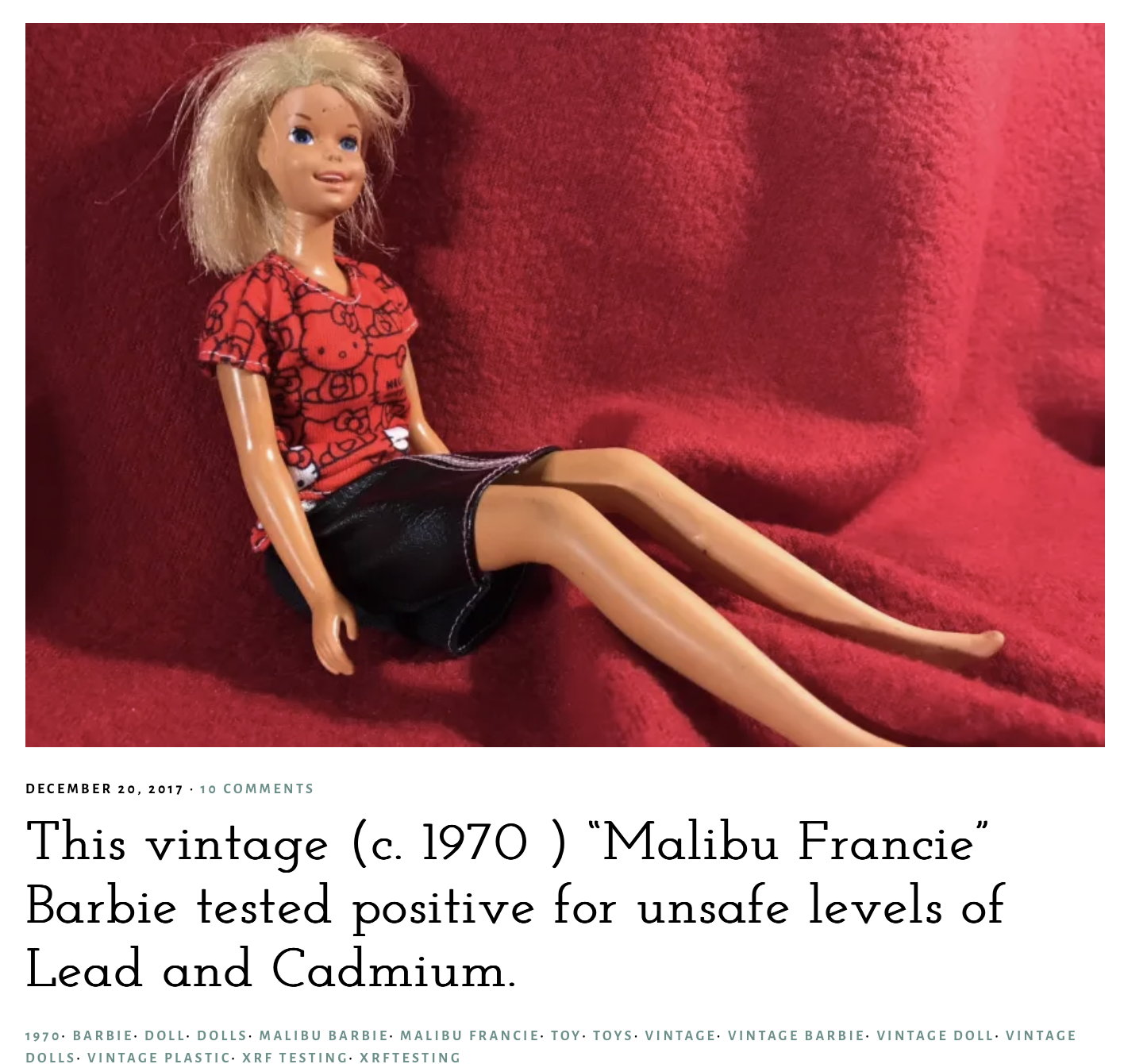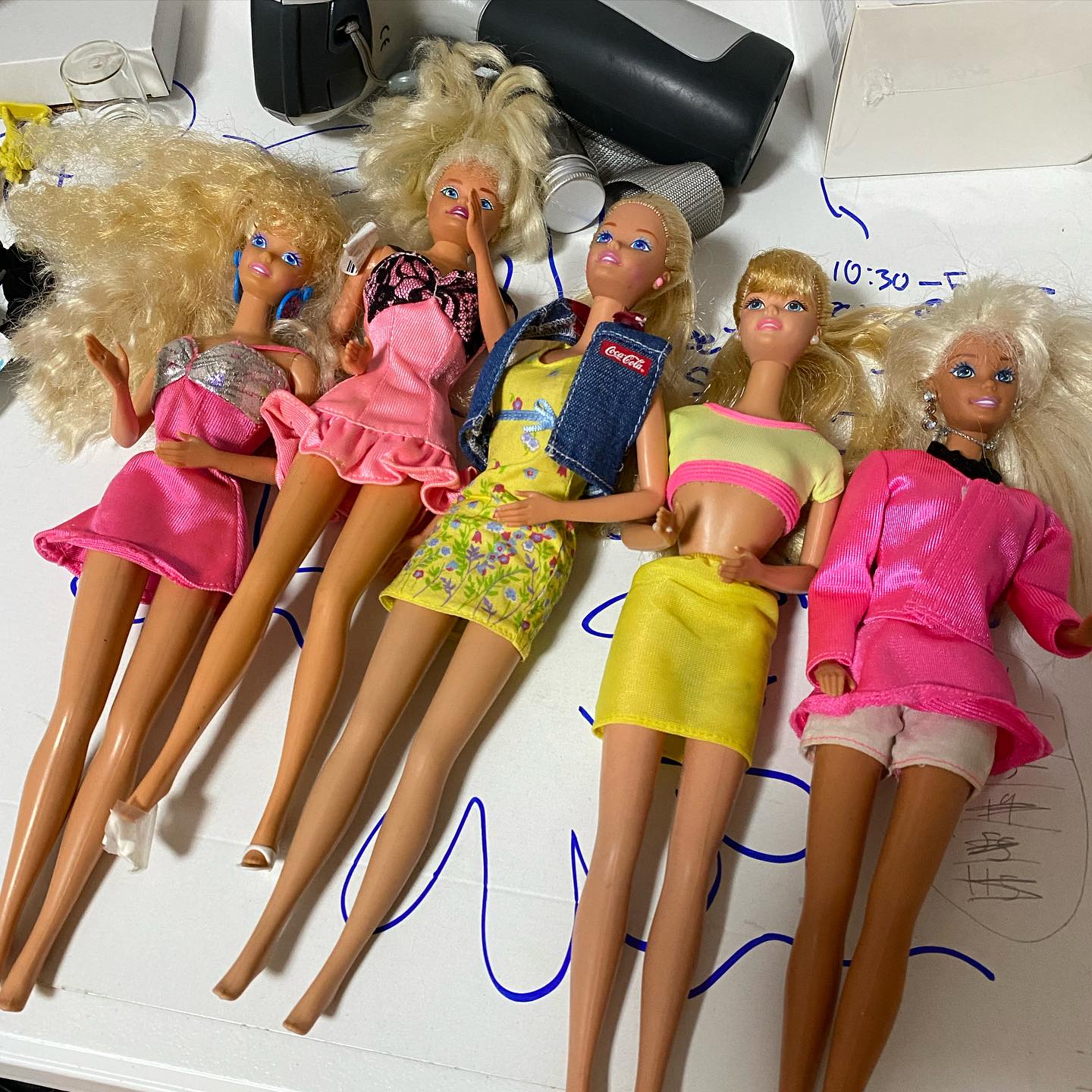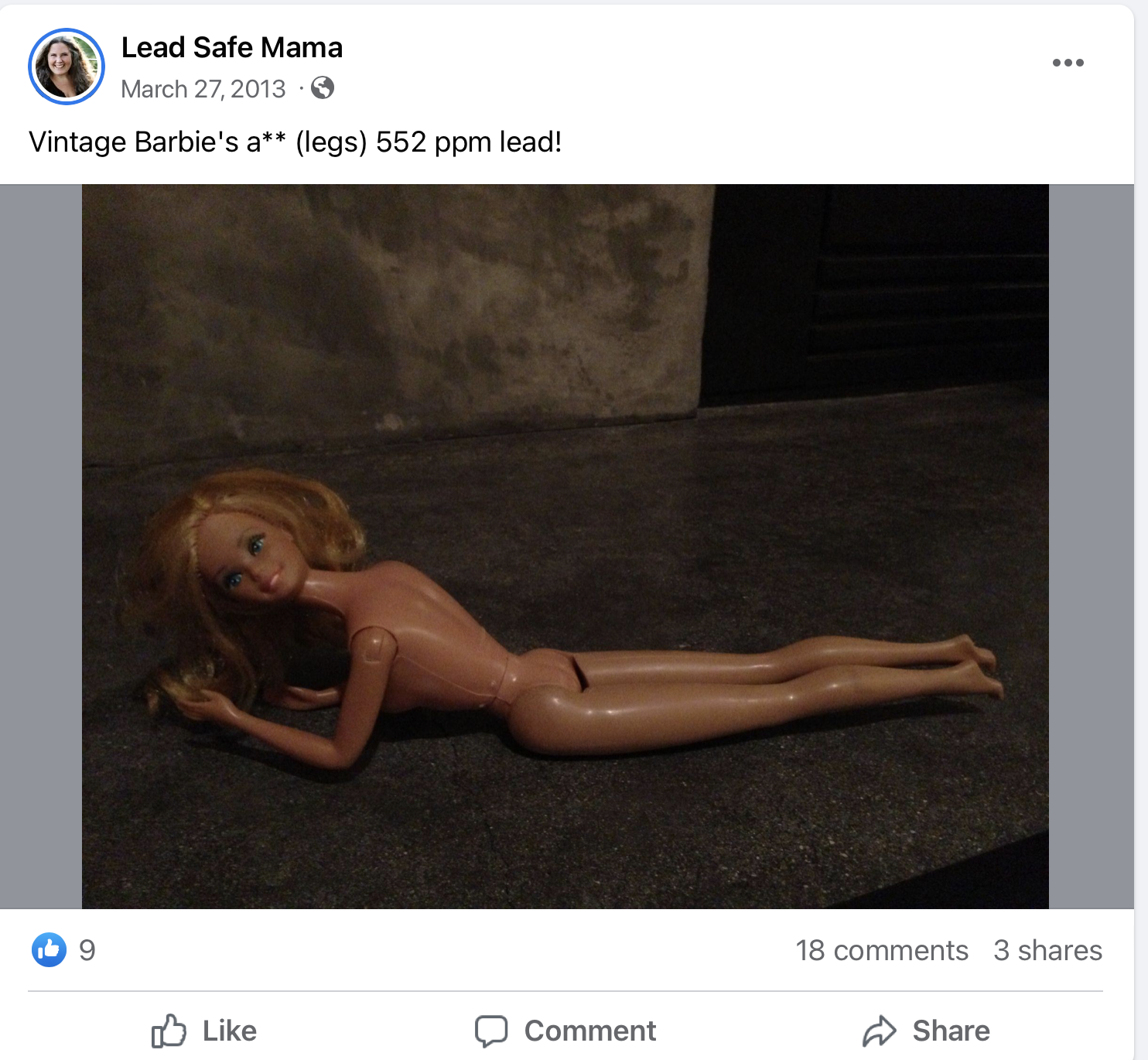Is your Barbie safe for your kids to play with? A discussion on the concern for unsafe levels of Lead (& other toxicants) in vintage Barbie dolls
For those new to this website:
Tamara Rubin is a multiple-federal-award-winning independent advocate for childhood Lead-poisoning prevention and consumer goods safety, and a documentary filmmaker. She is also a mother of Lead-poisoned children (two of her sons were acutely Lead-poisoned in 2005). Since 2009, Tamara has been using XRF technology (a scientific method used by the U.S. Consumer Product Safety Commission) to test consumer goods for toxicants (specifically heavy metals — including Lead, Cadmium, Mercury, Antimony, and Arsenic). All test results reported on this website are science-based, accurate, and replicable. Items are tested multiple times to confirm the test results for each component tested. Tamara’s work was featured in Consumer Reports Magazine in February of 2023 (March 2023 print edition).
Published: July 18, 2023
Tuesday
With all the “Barbie Frenzy” taking over the news cycle right now (vying for much of our attention online) I wanted to take a moment and remind you that vintage Barbie dolls are not safe for children to play with. Please click the image above to see XRF test results for one example of a toxic/ unsafe vintage Barbie-brand doll.
Please note that while “Vintage” is typically a term reserved for items that are at least 20 years old or older, in this case, I would say the concern is primarily for Barbie brand dolls made before 1990. Our testing has not yet determined if any Barbie dolls manufactured post-1990 have unsafe levels of toxicants or not. Separately, one can assume (with confidence) that any Barbie-brand products manufactured after 2010 are 100% certain to be safe for use by children (more on that below).
The “rule,” not the “exception”
As with most companies that began making toys decades before any regulatory standards were put in place to protect children from heavy metal exposure from consumer goods — the manufacturers of Barbie (Mattel) historically produced many different toys that had high levels of extremely neurotoxic heavy metals. If the same toys were manufactured today, they would be unequivocally illegal. Here’s an example (link) of a 1980s baby rattle/ teether manufactured by Mattel that tested positive for Lead, Cadmium, and Arsenic.
Mattel follows the expected “rule” for toxicants in toys (not the exception). They are well-established among the ranks of many other well-known “trusted” companies and brands with a history of making dangerously toxic products … companies including (but by no means limited to!) Lego, Mega Bloks, Fisher Price, Little Tikes, Brio, Tonka, Colorforms, Rubbermaid, Walt Disney, and countless others. Each of these companies has historically made many toxic children’s products, products that were never recalled (and are often still in use by children today) yet are not safe for children by modern standards.
For context: the modern regulatory standards limiting the presence of Lead in consumer goods manufactured for use by children (including toys) were introduced in 2008 with the “Consumer Product Safety Improvement Act of 2008” — which did not become fully enforceable (across all types of products and materials) until 2010/2011 (depending on the type of product). It is for this reason you will often hear me say that if you REALLY want to be sure your child’s toys are safe you should make sure they were manufactured after 2011 (or at least after 2010), allowing for the adjustment period required for companies to come into compliance with the CPSIA.
An attempt to gather some more data in this inquiry:
Over the past week or so I have invested a small fortune into purchasing a dozen (or more, I lost track!) vintage Barbies on eBay, trying to get a better sense of which Barbie-brand dolls specifically (which designs, manufactured in which decades) have unsafe levels of Lead, Cadmium and other heavy metals. I have focused this inquiry on trying to purchase vintage Barbie dolls from the 1970s and 1980s for starters.
I have personally tested dozens of Barbie-brand dolls over the years that have been found to have unsafe levels of Lead in one or more components. The Barbie dolls with unsafe levels of Lead (that I have come across so far) were manufactured and sold in both the 1970s and 1980s. I’m certain of the era of manufacture for these dolls as, in each case, the dolls I tested were during a one-on-one home consultation with a family and the dolls in question were the property of a parent in that family (one of the people who hired me — typically the mother). In ALL of these cases, the mother was the original owner of the dolls (often sharing something along the lines of, “I received this as a gift for my 5th birthday, which was in 1975,” or similar), so the age of the doll was confirmed through “provenance” of a sort. Unfortunately, I have not recorded every one of the (tens of thousands of) items I have tested during home consultations over the past 15 years — so my goal is to recreate some of that testing and document those findings this time around.
Until now I have not had the opportunity (nor the funding) to try and get a better sense of which particular dolls (which designs and which specific years of manufacture) were the most problematic. While waiting/hoping to be in a position one day to collect such fine-grain data, I have just generally cautioned parents about these (Barbie-brand dolls), advising parents of young children especially to not give any Barbies from the 1980s or earlier to children to play with — especially children who are, due to the age of the child (or diagnosed pica), likely to possibly mouth or chew on any part of any one of these dolls.
While I have been doing an extensive amount of research on the subject this month, I am finding that it is challenging (as a “non-Barbie expert”) to identify, with any level of certainty, which dolls were made in which decade. Some of the particular versions of the sculpted “faces” of the various Barbie-brand dolls were used across multiple decades. As an example, the Super Star Barbie face was — apparently, as I recently learned — used across at least three decades. And, further confusing the matter, while most have copyright dates molded into their bodies — as with quite a few Mattel toys — these dates (in many cases) denote the year the doll component was originally designed, NOT the year the component was manufactured.
Separately, even with dolls in mint original condition/ new in box, the year molded into the head is often different than the year molded into the body. The issue is compounded by the fact that some dolls are reproductions, introduced as faithful replicas of earlier dolls but manufactured in later decades. Additionally, when you buy these dolls used (not in “mint/ new in box” condition) you can never be 100% sure the head, body, and limbs, for that matter, were originally together; you might very well end up with the head of one doll on the body of a doll made in another era!
To help with this effort (identifying which decades of originally manufactured Barbies are more likely to be toxic/ unsafe) I have tried purchasing examples of specific doll designs that were only made/ sold during specific decades (Ballerina Barbie — with the original sculpted head, Kissing Barbie, etc.) So, hopefully,y this strategy will give us some more information and insight into toxicant profiles for all Barbie dolls made in those same decades (as I expect the plastics, rubbers, and paints used were likely quite similar within each generation of the doll, regardless of the doll’s specific design).
As I publish these additional Barbie articles (with test results for each doll) if YOU have more (reliable/confirmable) information about a particular doll that I shart, I would sincerely appreciate it if you could take the time to comment in the comment thread on the article for that doll.
Thank you for supporting this work in this way!
Tamara Rubin
Owner — Lead Safe Mama, LLC
A photo with some of the dolls I purchased this month:

Some additional reading for those who are interested:
- More Barbie-related articles here on LeadSafeMama.com
- More dolls we have tested for toxicants
- Specifically, more VINTAGE dolls we have tested
- More vintage TOYS we have tested
- More TOYS we have tested (vintage and new)
- Will this item poison me? — An article
- The impact of low-level Lead exposure in children — An article
- What do we use to test for toxicants (heavy metals)? — An article
- The Lead Safe Mama, LLC “About” page, for those who are new here
Some safer (Lead-free) choices
As noted above, modern Barbie dolls (and dolls from any brand for that matter) made after 2010 should be fully compliant with the Consumer Product Safety Improvement Act of 2008 (CPSIA) and therefore should be safe for children (negative for toxicants including Lead and Cadmium) as long as the doll is a product that is/was sold and marketed with language indicating it was created expressly for use by children.
Items (including dolls) sold as “collectibles” or with a tag stating they are “not intended for use by children” are likely to be positive for unsafe levels of one or more toxicants (Lead, Cadmium, Mercury, Arsenic, Antimony, etc.) and should not be given to children to be played with.
*Amazon links are affiliate links. If you purchase something after clicking on one of our links we may receive a small percentage of what you spend — at no extra cost to you.
I first wrote about this issue in 2013.
Here’s one of my original social media posts
(March 27, 2013 — more than 10 years ago.)
Never Miss an Important Article Again!
Join our Email List












Thank you for the work you do! Do the current Barbie dolls on store shelves today contain lead? My daughter will be disappointed if I have to take these away, but her health is more important.
No – they do not. Post-2010 Barbie Dolls are 100% safe.
T
Hi,
Do the Barbie’s dolls from 1990-2000 contain lead?
Thank you
It looks like they are safe – still working on additional testing
Hello!
I am happy to hear that so far you haven’t found anything on the newer dolls. I am a 90s child and I still have my Barbies from the early 2000s. Have you done any tests on barbie dolls from that period?
Best regards,
Presi
Honestly I would like to say thank u!!! This is the first page I found that contain real information about all of this. I was a collector of Barbie doll, specifically from 90’s to 2010’s dolls. Then I stopped when I try to found information about PVC and all the chemical composition in Barbie doll. Well now at least, I will get one of the newest one to have without feeling worried about it, thank u!!
PS: as a collector I can help you if you need more info about an specific doll, I know most of them!! 🙂
Hi Jorge, do you know how the chemists at Mattel achieved the softer/squishier parts of a Barbie doll (of any era?) Such as the head or limbs of some Barbies. I am mostly curious as an aspiring toy maker but also curious if those parts are toxic.
I was looking for something else & saw this on Wikipedia, “In 2002, Mattel closed its last factory in the United States; the factory was originally part of Fisher-Price outsourcing production to China. A chain of events followed that led to its distribution of millions of hazardous toys, including ones contaminated with lead.[73] On August 14, 2007, Mattel recalled over 18 million products, with Louise Story of The New York Times in close coverage.[74][75][76] Many of the products had surface coatings that contained more than the U.S. legal limit of .06% lead by weight.[76] Other toys were recalled because their strong, detachable magnets could endanger children. Mattel re-wrote its policy on magnets, finally issuing a recall in August 2007.[77] The recall included 7.1 million Polly Pocket toys produced before November 2006, 600,000 Barbie and Tanner Playsets, 1 million Doggie Daycare, Shonen Jump’s One Piece and thousands of Batman Manga toys due to exposed magnets.[77] In 2009, Mattel paid a $2.3 million fine to the Consumer Products Safety Commission for marketing, importing and selling non-compliant toys.[78] Mattel was noted for its crisis response by several newspaper publications, including PRWeek, the Los Angeles Times, Fortune and Business Management.[79][80][81]”
I never heard anything about this recall. But I thought you might want to review a more detailed list & post it. Apologies if I missed it & you already posted on here! https://service.mattel.com/us/recall/default.asp?recall_id=52430
Hello!
Thank you for this great post. I was wondering, have you by any chance performed testing (before and after washing the fabric) on Barbie clothes that belonged to a vintage doll? Does a toxic material remain in the fabric and can it be washed off? Thank you.
The toxic material remains in the fabric.
T